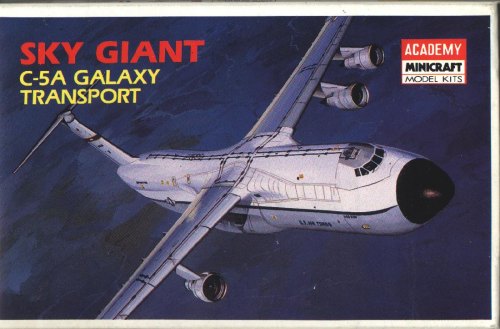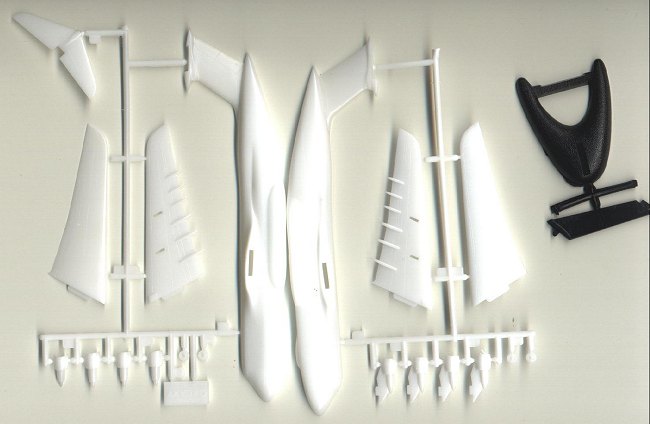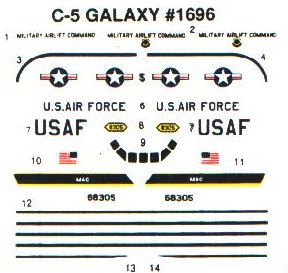
|
KIT: |
Minicraft 1/480 C-5A Galaxy |
|
KIT # |
1696 |
|
PRICE: |
@$5.00 retail |
|
DECALS: |
One option |
|
REVIEWER: |
Julien Dixon |
|
NOTES: |
A small kit of a large aircraft! |

|
HISTORY |
In 1961 several aircraft companies began design studies of a heavy logistic jet transport intended to replace and augment the capabilities of the aging Douglas C-133 and complement the existing fleet of C-141 jet-powered transports. The aircraft was intended to deliver payloads in the range of 100 000 to 200 000 pounds over intercontinental distances and be able to operate from semiprepared runways.
Following a design competition, Boeing, Douglas, and Lockheed were given contracts for further development of their designs. Concurrently, General Electric and Pratt & Whitney were given design contracts for high-bypass-ratio turbofan engines to power the new aircraft. The weight of the aircraft was expected to be in the 700 000-pound class, and the thrust level required of the new engines was about 40 000 pounds.
The selection of the General Electric Company to develop the engine was announced in August 1965, and on 30 September 1965, Secretary of Defence McNamara announced that Lockheed had won the airframe production contract. For the program's first increment—the 58 aircraft of Production Run A., this would almost surely be followed by the procurement of another 57 C–5As, referred to as Production Run B. Finally, a last buy of 85 aircraft, or Production Run C, was anticipated. This award came at a critical time for Lockheed as C–141 production was coming to an end, threatening to shut down the enormous, government-owned Marietta plant, which Lockheed leased, and deliver a damaging economic blow to the state of Georgia.
The first C-5A was delivered to the Transitional Training Unit at Altus Air Force Base, in December 1969. The first operational C-5s were delivered to the 437th Military Airlift Wing, Charleston Air Force Base, S.C., in June 1970.In September 1970 the first squadron in the Military Airlift Command (MAC) attained initial operational capability (IOC) at Charleston Air Force Base (AFB), South Carolina. The IOC lagged more than a year behind the original schedule, and several months beyond a revised date established on 17 December 1969, when MAC took delivery of its first C–5A. The operational C–5As at Charleston, moreover, experienced considerable difficulty with their landing gear, forcing postponement of the squadron's IOC until September.
SpecificationsPrimary Function:
Outsize cargo transport
Prime Contractor:
Lockheed-Georgia Co.
Power Plant:
Four General Electric TF-39 engines
Thrust: 43,000
pounds, each engine
Wingspan: 222.9 feet (67.89 meters)
Length: 247.1 feet (75.3 meters)
Height: 65.1 feet (19.84 meters)
Cargo Compartment: height , 13.5
feet (4.11 meters); width, 19 feet (5.79 meters); length, 143 feet, 9 in
(43.8 meters)
Pallet Positions: 36
Maximum Cargo: 270,000 pounds
(122,472 kilograms)
Maximum Takeoff Weight: C-5B 769,000
pounds (348,818 kilograms) (peacetime), 840,000 pounds (381,024
kilograms) (wartime)
Speed: 518 mph (.77 Mach)
Range: 6,320 nautical miles (empty)
Crew: 7 (pilot, co-pilot, two flight
engineers and three loadmasters)
Unit Cost: C-5A - $152.8 million
(FY98 constant dollars) C-5B - $179 million (FY98 constant
dollars)
Deployed: C-5A - 1969, C-5B -
1980
Inventory: Active force and Reserve,
126
|
THE KIT |

The kit is 2 small white plastic sprues, these are the main aircraft parts and a small black one with the main stand. There are only 22 parts in total so no room for any options, what you see is what you get.
Given the scale there are not
many parts to the kit, the main fuselarge is split in two down the
middle, two piece main wings and a single piece tail. The white plastic
seems fairly hard and all the detail is raised so some will be lost in
the making.

The engines are a 3 part assembly each consisting of two halves and a front fan.
As the scale is 1/480 no landing gear is supplied, the model is to be mounted on a two-part stand which is supplied. An aircraft name plate is also supplied for the stand if wanted.
A small decal sheet is provided which gives the more basic details, for a standard early MAC scheme of white over grey. Included are; the cockpit windows, the MAC tailflash, main cheat line, US AIR FORCE Titles and the stars & Bars. None of the extensive wing walkway markings on the box view are provided so it would be up to the modeller to provide these if wanted. On this sheet the Stars and bars are off register and will have to be replaced, though where you will get new ones in this scale I don’t know.
|
CONCLUSIONS |
My overall impressions are it is a small kit with some potential, I have always wanted a kit of one ever since I saw my first Galaxy at RAF Mildenhall and now I can have one without having to get an extension built! It would be good to do in the euro 1 scheme but I doubt you would be able to find any markings for this scale?
Preview courtesy of me agreeing to build a truck model?!
|
REFERENCES |
References:
www.theaviationzone.com/factsheets/c5.asp
www.lmaeronautics.com/products/airmobility/c5/
www.air-and-space.com/galaxy.htm
www.globalsecurity.org/ military/systems/aircraft/c-5.htm
If you would like your product reviewed fairly and quickly by a
site that has over 250,000 visitors a month, please contact
me or see other details in the
Note to
Contributors.